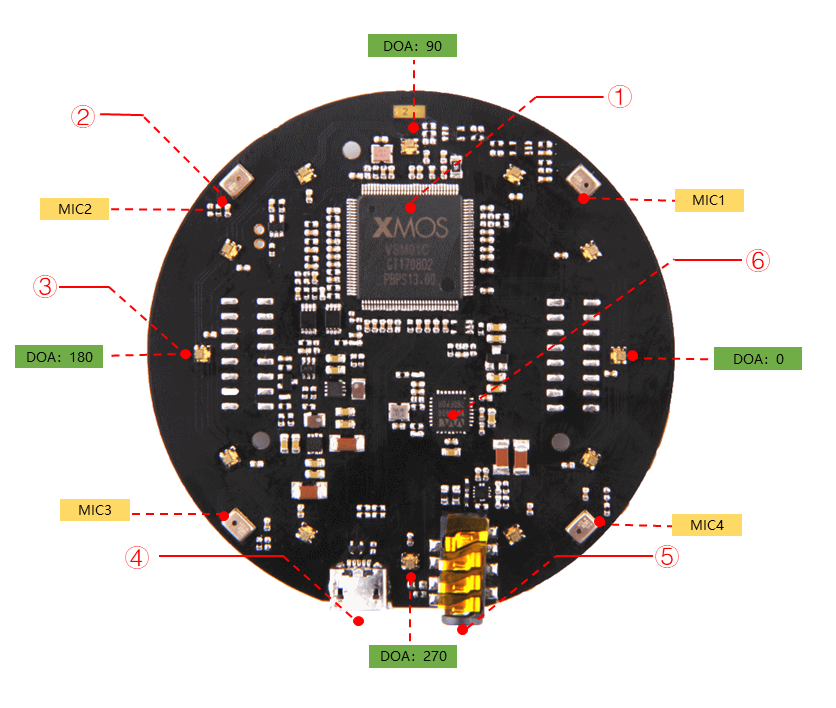
Microphone arrays are clusters of multiple microphones arranged to capture spatial audio information. They enable humanoid robots to perform advanced auditory tasks such as sound source localization, beamforming, noise suppression, and voice recognition in dynamic environments.
Here’s a detailed list of microphone arrays suitable for humanoid robots:
Key Features to Consider in Microphone Arrays
- Number of Microphones: More microphones improve spatial resolution and noise cancellation.
- Beamforming Capabilities: Essential for focusing on sound from specific directions.
- Noise Reduction: Reduces background noise for clearer audio processing.
- Integration: Ensure compatibility with robotic platforms like ROS, Raspberry Pi, or Jetson.
- Far-Field Support: Important for capturing distant sound sources in dynamic environments.
- Processing Power: Onboard DSPs or FPGA support for real-time processing.
Applications of Microphone Arrays in Humanoid Robots
- Speech Recognition: Enhances the robot’s ability to recognize commands in noisy environments.
- Sound Source Localization: Enables the robot to identify the direction of sound sources.
- Noise Cancellation: Improves auditory clarity in real-world scenarios.
- Human-Robot Interaction: Facilitates natural and responsive communication.
- Environmental Awareness: Detects auditory cues for navigation or alert systems.
These microphone arrays empower humanoid robots with advanced auditory perception, critical for natural and efficient interactions in various environments.
Robot Related Post: A Timeline for Building an Advanced Humanoid
1. ReSpeaker Mic Array v2.0
- Description: A popular microphone array for robotic and IoT applications, designed for far-field voice capture.
- Features:
- 4 high-quality microphones.
- Beamforming and echo cancellation.
- 6 LED indicators for real-time status.
- Compatible with Raspberry Pi, Arduino, and other platforms.
- Applications: Voice assistants, speech recognition, far-field audio capture.
- Examples: ReSpeaker Mic Array v2.0.
2. Seeed ReSpeaker 6-Mic Circular Array
- Description: A circular microphone array optimized for 360-degree sound capture.
- Features:
- 6 microphones in a circular arrangement.
- Supports direction of arrival (DoA) estimation.
- Compatible with Raspberry Pi and other development platforms.
- Built-in algorithms for noise reduction and beamforming.
- Applications: Voice-controlled robots, telepresence systems, human-robot interaction.
- Examples: ReSpeaker 6-Mic Array.
3. Matrix Voice
- Description: A highly customizable microphone array for edge computing and IoT projects.
- Features:
- 8 MEMS microphones.
- FPGA for real-time processing.
- Compatible with multiple programming environments (Python, C++).
- Integrated LED ring for visual feedback.
- Applications: Speech processing, smart home systems, robotic auditory systems.
- Examples: Matrix Voice.
4. XMOS VocalFusion Microphone Array
- Description: A professional-grade microphone array with advanced audio processing capabilities.
- Features:
- 4-microphone linear array.
- Far-field voice capture up to 5 meters.
- Integrated noise suppression and acoustic echo cancellation (AEC).
- Supports integration with major voice AI platforms like Alexa and Google Assistant.
- Applications: Voice assistants, teleconferencing, humanoid auditory systems.
- Examples: XMOS VocalFusion.
5. MiniDSP UMA-16 Microphone Array
- Description: A high-density microphone array for advanced sound source localization.
- Features:
- 16 MEMS microphones in a compact layout.
- USB interface for easy integration.
- Support for beamforming and audio spatialization.
- High signal-to-noise ratio (SNR).
- Applications: Robotic auditory systems, sound localization, advanced acoustic processing.
- Examples: MiniDSP UMA-16.
6. Nvidia Jetson AGX Microphone Arrays
- Description: Arrays designed to complement the Nvidia Jetson platform for AI and robotics applications.
- Features:
- Multi-microphone configurations.
- Optimized for deep learning-based speech processing.
- Hardware acceleration for real-time processing.
- ROS-compatible drivers and support for AI frameworks.
- Applications: AI-powered auditory systems, noise cancellation, natural language interaction.
- Examples: Custom microphone arrays integrated with Jetson AGX Xavier.
7. Acusis Mic Array
- Description: Compact and high-performance microphone array for robotic systems and voice interfaces.
- Features:
- 4 high-quality MEMS microphones.
- Integrated beamforming and noise suppression.
- Low-latency audio processing.
- Plug-and-play compatibility with various systems.
- Applications: Humanoid robots, voice-enabled systems, conference setups.
- Examples: Acusis Pro.
Related Post: Communication Systems For Humanoid Robots
8. TDOA-Based Microphone Arrays
- Description: Arrays designed for Time Difference of Arrival (TDOA) sound localization.
- Features:
- Configurable microphone spacing for optimized DoA.
- Real-time sound localization.
- Cross-platform support with open-source libraries.
- Applications: Source localization, auditory SLAM, multi-sound tracking.
- Examples: Custom TDOA arrays from developers like SparkFun or Adafruit.
9. Respeaker Core v2.0
- Description: A complete development kit with a built-in microphone array for voice and audio applications.
- Features:
- 6-microphone array with far-field audio support.
- Integrated speech algorithms (AEC, VAD).
- Open-source SDKs for developers.
- Compatibility with multiple programming environments.
- Applications: Voice-controlled robots, human-robot interaction, auditory research.
- Examples: ReSpeaker Core v2.0.
10. Alango Microphone Arrays
- Description: Professional audio processing solutions with focus on high-quality voice capture.
- Features:
- Noise reduction, AEC, and beamforming algorithms.
- Multi-microphone setups for wide-area coverage.
- Hardware-optimized for audio quality.
- Applications: Humanoid robotics, smart conference systems, human-robot interaction.
- Examples: Alango Microphone Arrays.
